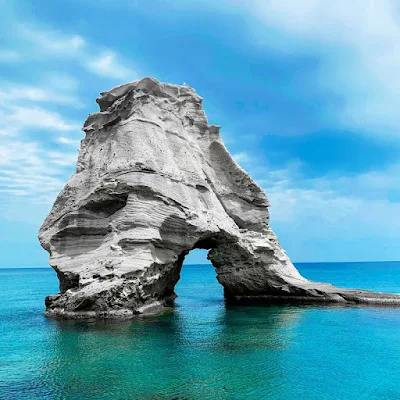Milos Island, a volcanic marvel nestled within the Cyclades archipelago of the Aegean Sea, enchants visitors with its dramatic landscapes, pristine beaches, and rich cultural heritage.
From ancient ruins to serene coves, Milos unveils a captivating blend of natural beauty and historical significance.
1. Volcanic Origins:
Milos's volcanic genesis has sculpted a mesmerizing terrain, characterized by towering cliffs, secluded coves, and subterranean wonders.
2. Beach Paradise:
Milos boasts over 70 beaches, each with its unique charm. From the lunar-like expanse of Sarakiniko to the secluded beauty of Papafragas, Milos's coastline offers a haven for sun-seekers and adventurers alike.
3. Roman Amphitheater:
Step back in time at the Roman amphitheater, a testament to Milos's ancient past. Constructed in the 2nd century AD, this impressive structure once hosted gladiatorial contests and public spectacles.
4. Catacombs of Trypiti:
Explore the subterranean labyrinth of the Trypiti Catacombs, a Christian necropolis dating back to the 1st century AD. Wander through the eerie passages, lined with niches that once held the remains of early Christians.
5. Hiking Trails:
Embark on a journey of discovery along Milos's diverse hiking trails. From the leisurely stroll to the Plaka Catacombs to the challenging ascent to the Adamas Caves, Milos offers trails to suit all levels of experience.
6. Sailing Paradise:
Set sail on the cerulean waters of the Aegean, navigating around Milos's captivating coastline. Discover hidden coves, picturesque villages, and neighboring islands, all while enjoying the serenity of the sea.
7. Windsurfing and Kitesurfing:
Harness the power of the Aegean winds and experience the thrill of windsurfing or kitesurfing. Milos's coastal conditions provide an ideal setting for both beginners and experienced enthusiasts.
8. Yoga and Meditation Retreats:
Immerse yourself in the tranquil ambiance of Milos and find inner peace at one of the island's many yoga and meditation retreats. Embrace the serenity of the surroundings and reconnect with your mind and body.
9. Culinary Delights:
Indulge in the flavors of Milos, where traditional Greek cuisine reigns supreme. Savor the rich aromas of moussaka, the succulent flavors of souvlaki, and the refreshing sweetness of Greek yogurt.
10. Honeymoon Haven:
Milos's idyllic setting and romantic ambiance make it an enchanting destination for newlyweds. Celebrate your love amidst the island's natural splendor and create memories that will last a lifetime.
Milos Island, with its captivating blend of natural beauty, ancient history, and cultural richness, invites exploration and discovery. Whether seeking relaxation, adventure, or cultural immersion, Milos promises an unforgettable sojourn, leaving an indelible mark on the hearts of its visitors.

Comments
Post a Comment